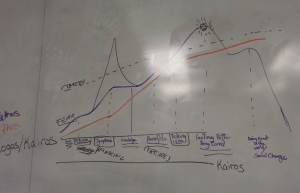(Sean Molloy 22 Aug. 2014)
Overview: After reading a Chapter “FIlms as Roller Coasters” from Dona Cooper’s Writing Great Screenplays For Film and TV, students adapt Cooper’s ideas to analyze the rhetorical intensity of different rhetorical appeals in their own draft movies, screenplays or treatments by drawing a multi-track “roller coaster” showing how elements in the movie invoke different appeals.
Teaching Goals/Theoretical Rationale: Making these roller coasters allow students to explore Dona Cooper’s argument in “Films as Roller Coasters” (1997) that emotional intensity is critical to effective movies. Bridging beyond Cooper’s focus on emotional appeals, they can gauge the rhetorical intensity of their own movies.
This assignment could be used as a variation of Kenneth Bruffee’s descriptive (says/does) outline for any text– thinking rhetorically about what a text does and how it does it, rather that merely what it says. (Bruffee’s says/does outline is described by Elbow and Belanoff (40-43).) The roller coaster is less robust than the full “says/does” outline, but it also adds Cooper’s intensity idea which applies powerfully to visual rhetoric. In my version, students analyze a movie version of an essay they have already written in text form, so this exercise offers a chance for meta-analysis of differing rhetorical appeals in these different genres.
Tips From Past Classroom Uses: I have struggled to use Bruffee’s “Says/Does” outlines as writer or peer exercises. Elbow and Belanoff warn that these outlines require “a sustained process of analyzing the meaning and function of discourse” (40). Such outlines challenge students to see their work rhetorically– but they take a long time to complete and my FYW students have seemed to struggle to complete them. I tried this roller coaster version in Spring 2014 and it easily fit into a single 75 minute class period, including some time to review rhetorical concepts in advance and then to workshop and redraw some of the outlines based on class discussion.
Scaffolding: In my FYW course, this follows a unit on rhetoric that introduced ethos, logos, pathos and kairos. This assignment reviews those concepts in a new context and scaffolds toward a movie essay project.
Variations/Examples of Student Work: These roller coasters can be created using many digital tools, or with pen and paper. I have made test versions using excel and google docs. Two student created examples using a white board are above. In the version on the right, Hunter student Tanya Tavaris gauges the intensity of ethos and pathos in her medical-commercial-parody movie. using a case study method, her thesis question asked whether our FYW class avoided the banking model and met the critical teaching requirements of praxis in Paulo Friere’s Pedagogy of the Oppressed. Tanya’s text essay is in her website portfolio. Both her movie and website portfolio, with her permission, are here. In the center is a google docs drawing roller coaster I made of a digital literacy narrative movie I composed for a Sondra Perl class, that tracks my ethos/pathos and logos appeals.
Assigned Readings: Cooper, Dona. “Films as Roller Coasters.” Writing Great Screenplays For Film and TV. 2d ed. New York: Macmillan, 1997. 1-10. Print.
Assessment: I have not yet formally assessed or graded these roller coasters. So far, I’ve used them as low-stakes, writing process/rhetorical analysis exercises.
Work Cited:
Elbow, Peter and Pat Belanoff. Sharing and Responding. 3rd ed. Boston: McGraw Hill, 2000. Print.




